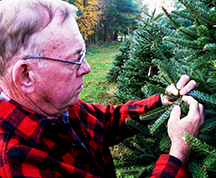Another good year for Indiana Christmas trees
November 25, 2014
 |
|
Dan Cassens, Purdue University professor of wood products, examines a Canaan (ka-NAYN’) fir tree on his tree farm in West Lafayette, Indiana. (Purdue Agricultural Communication photo/Keith Robinson) |
WEST LAFAYETTE, Ind. - An abundance of rain and cool temperatures this year that helped Christmas trees in Indiana develop well bid good tidings for shoppers wanting a fresh tree for their home, a Purdue University wood products specialist says.
Dan Cassens said the drought of 2012 was a challenge for the industry because of the stress it caused trees, with many dying.
“We thought we could lose all the trees,” said Cassens, who owns a tree farm in West Lafayette. “But the stronger trees prevailed, and last year the trees looked good by the time Christmas season came around.”
Trees continued to get strong this year because the weather favored healthy growth.
“This year, with the rain and cooler weather, the trees just grew beautifully,” Cassens said. “They were just really doing the best that they absolutely could.”
Cassens said fir trees and Scotch pine, the most common Christmas tree species in Indiana, are the longest lasting trees when used indoors. Many people will put up their Christmas tree the day after Thanksgiving and keep it until after New Year.
Fir trees, such as the Frasier and Canaan (ka-NAYN’), cost about twice as much as a Scotch or white pine, Cassens said.
Cassens, a member of the National Christmas Tree Association, listed steps for consumers to keep in mind when buying and caring for a real tree:
* Size of the room, size of the tree: Cassens said that buying a tree that is too tall for a room can be wasteful because you will end up trimming the tree to make it fit, thereby spending more on the tree than what was necessary.
* Selecting a species: Once the right size of the tree has been determined, decide which species you want.
* Straightness of tree trunk: Fir trees are typically a straight-growing tree. Scotch pines tend to have some crooks in them.
* Freshness of tree: Insects or mechanical problems can cause yellowness. If a tree has any yellow spots, it is best to avoid them unless they are in a place that could be cut out.
* Base of tree: It is best to have a clean 6-8 inches to put into the handle of the tree stand. This will prevent having to cut any limbs that would leave bare spots in the base of the tree.
Cassens said it is most important to remember that the tree always needs water. With no water in the stand, the tree will start to dry out and not last as long.
In the end, Cassens said the best thing to consider when shopping for a Christmas tree is to pick the one that is most appealing to you.
“What species it is or how it looks doesn’t make that much difference,” he said. “Find the one you like and be happy with it.”
For more information, Purdue Extension has a free publication, Tips for First-time Buyers of Real Christmas Trees, available at The Education Store at https://www.edustore.purdue.edu/.
Writer: Carlee Glassburn, 765-496-2384, cglassbu@purdue.edu
Source: Dan Cassens, 765-494-3644, dcassens@purdue.edu
Ag Communications: (765) 494-2722;
Keith Robinson, robins89@purdue.edu
Agriculture News Page

